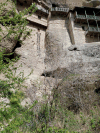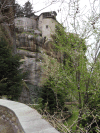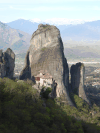
View of the rock pillars of Meteora. (989k)
From the Meteora entry in Wikipedia:
The Meteora is a rock formation in central Greece hosting one of the largest and most precipitously built complexes of Eastern Orthodox monasteries, second in importance only to Mount Athos. The six (of an original twenty-four) monasteries are built on immense natural pillars and hill-like rounded boulders that dominate the local area. Between the 13th and 14th century, the twenty-four monasteries were established atop the rocks. Meteora is located near the town of Kalabaka at the northwestern edge of the Plain of Thessaly near the Pineios river and Pindus Mountains.
The name means "lofty", "elevated", and is etymologically related to meteor.
Beside the Pindos Mountains, in the western region of Thessaly, these unique and enormous columns of rock rise precipitously from the ground. But their unusual form is not easy to explain geologically. They are not volcanic plugs of hard igneous rock typical elsewhere, but the rocks are composed of a mixture of sandstone and conglomerate.
The conglomerate was formed of deposits of stone, sand, and mud from streams flowing into a delta at the edge of a lake, over millions of years. About 60 million years ago during the Paleogene period a series of earth movements pushed the seabed upward, creating a high plateau and causing many vertical fault lines in the thick layer of sandstone. The huge rock pillars were then formed by weathering by water, wind, and extremes of temperature on the vertical faults. It is unusual that this conglomerate formation and type of weathering are confined to a relatively localized area within the surrounding mountain formation. The complex is referred to an exhumed continental remnant of Pangean association.
This type of rock formation and weathering process has happened in many other places locally and throughout the world, but what makes Meteora's appearance special is the uniformity of the sedimentary rock constituents deposited over millions of years leaving few signs of vertical layering, and the localized abrupt vertical weathering.
Caves in the vicinity of Meteora were inhabited continuously between 50,000 and 5,000 years ago. The oldest known example of a built structure, a stone wall that blocked two-thirds of the entrance to the Theopetra cave, was constructed 23,000 years ago, probably as a barrier against cold winds – the Earth was experiencing an ice age at the time – and many Paleolithic and Neolithic artifacts of human occupation have been found within the caves.
Meteora is not mentioned in classical Greek myths nor in Ancient Greek literature. The first people documented to inhabit Meteora after the Neolithic Era were an ascetic group of hermit monks who, in the ninth century CE, moved up to the ancient pinnacles. They lived in hollows and fissures in the rock towers, some as high as 550 m (1,800 ft) above the plain. This great height, combined with the sheerness of the cliff walls, kept away all but the most determined visitors. Initially, the hermits led a life of solitude, meeting only on Sundays and special days to worship and pray in a chapel built at the foot of a rock known as Dupiani.
As early as the eleventh century, monks occupied the caverns of Meteora. However, monasteries were not built until the fourteenth century, when the monks sought somewhere to hide in the face of an increasing number of Turkish attacks on Greece. At this time, access to the top was via removable ladders or windlass. Currently, getting up there is a lot simpler due to steps being carved into the rock during the 1920s. Of the 24 monasteries, only six (four of men, two of women) are still functioning, with each housing fewer than ten individuals.
The exact date of the establishment of the monasteries is widely believed to be unknown, however there are clues to when each of the monasteries were constructed. By the late eleventh and early twelfth centuries, a rudimentary monastic state had formed called the Skete of Stagoi and was centered around the still-standing church of Theotokos (Mother of God). By the end of the twelfth century, an ascetic community had flocked to Meteora.
In 1344, Athanasios Koinovitis from Mount Athos brought a group of followers to Meteora. From 1356 to 1372, he founded The Great Meteoron Monastery on the Broad Rock, which was perfect for the monks; they were safe from political upheaval and had complete control of the entry to the monastery. The only means of reaching it was by climbing a long ladder, which was drawn up whenever the monks felt threatened.
At the end of the fourteenth century, the Byzantine Empire's reign over northern Greece was being increasingly threatened by Turkish raiders who wanted control over the fertile plain of Thessaly. The hermit monks, seeking a retreat from the expanding Turkish occupation, found the inaccessible rock pillars of Meteora to be an ideal refuge. More than 20 monasteries were built, beginning in the fourteenth century; only six remain today.
In 1517, Theophanes built the monastery of Varlaam, which was reputed to house the finger of St. John and the shoulder blade of St. Andrew.
Access to the monasteries was originally (and deliberately) difficult, requiring either long ladders latched together or large nets used to haul up both goods and people. This required quite a leap of faith – the ropes were replaced, so the story goes, only "when the Lord let them break". In the words of UNESCO, "The net in which intrepid pilgrims were hoisted up vertically alongside the 373 m (1,224 ft) cliff where the Varlaam monastery dominates the valley symbolizes the fragility of a traditional way of life that is threatened with extinction."
Until the seventeenth century, the primary means of conveying goods and people from these eyries was by means of baskets and ropes.
In 1921, Queen Marie of România visited Meteora, becoming the first woman ever allowed to enter the Great Meteoron monastery.
In the 1920s there was an improvement in the arrangements. Steps were cut into the rock, making the complex accessible via a bridge from the nearby plateau. During World War II the site was bombed.
Meteora is a UNESCO World Heritage Site.
All pictures are © Dr. Günther Eichhorn, unless otherwise noted.




































This page contains 36 pictures
Here are the links to the other main pages on Greece:
Page last updated on Fri Jul 8 18:53:28 2022 (Mountain Standard Time)